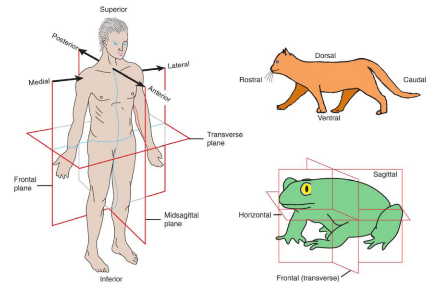In many disciplines, anatomical coordinates are used to describe the location of a feature in or on an organism's body.
The coordinates used to locate features on an organism depend on the physiology of that organism. The way an organism stands is one factor that influences which terms are used; for bipedal organisms (like people) the way planes are oriented is different than for quadrupedal creatures. For example, you can see in the picture that the transverse plane goes horizontally through the bipedal organism's belly. In a quadrupedal organism, it would go vertically to intersect the belly.
The type of symmetry in its body plan is another factor; while many species are bilaterally symmetrical, some (like starfish) are radially symmetrical.
Here's a list of some anatomical coordinate and an explanation of each terms, or pair of terms if applicable.
Superior/inferior: From the top of an organism to the bottom of an organism, moving vertically.
Ex: In humans, the feet are inferior to the knees.
Posterior/anterior: From the front of an organism to the back of an organism, moving horizontally.
Ex: Sharks have a pelvic fin anterior to their anal fin.
Medial/lateral: Close to an organism's midline to far from an organism's midline, moving outward from the center.
Ex: When it comes to the features on your head, your ears are lateral and your nose is medial.
Dorsal/ventral: From an organism's back to and organism's belly.
Ex: Chimpanzee infants ride ventrally on their mothers by clinging to their stomachs.
Rostral/caudal: From an organism's nasal region to an organism's tail/hind region.
Ex: On a dog's head, its eyes are located rostrally compared to its ears.
Sagittal: A bilateral split separating the left side of an organism from the right side of an organism. Think of a hot dog in a bun.
Ex: Gorillas have a huge sagittal crest of bone on top of their skulls, to which their sizable jaw muscles are attached.
Horizontal/transverse: A bilateral split separating the top of an organism from the bottom of an organism. Think of a hamburger on a bun.
Ex: Zebra legs are marked with horizontal/transverse stripes.
Frontal/coronal: A bilateral split separating the belly of the organism from the back of the organism.
Ex:
Proximal/distal (not illustrated): Close to the point of origin from the body to far from the point of origin from body.
Ex: Elephants have nostrils on the distal ends of their trunks.
